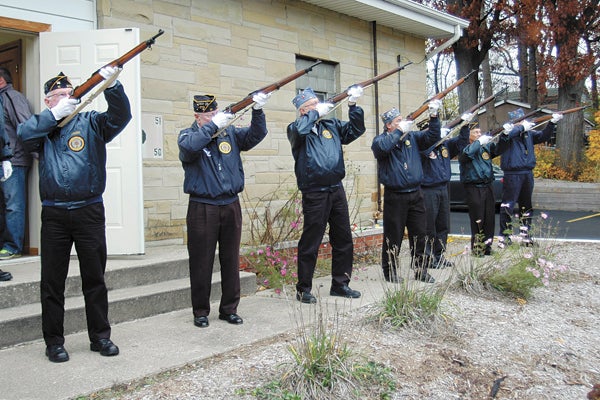German prisoners worked on southwest Michigan farms
Published 8:20 am Tuesday, November 12, 2013

Members of the Buchanan American Legion perform a 21-gun salute on Veterans Day. Leader Photo/CRAIG HAUPERT
BUCHANAN — While the United State’s able-bodied men and women were off fighting the Axis powers during World War II, thousands of German prisoners of war were harvesting the fruit crops in southwestern Michigan and laboring in fields all over northern America.
More than 500,000 German soldiers captured by the Allied forces were shipped to labor camps in the United States and elsewhere from 1943-46.
“There was a real shortage of labor,” said Howard Poole, retired Western Michigan University professor, during a Veterans Day program Monday at the Buchanan American Legion. “We were down to using junior high school kids to harvest crops. They (German POWs) became a labor source we could use.”
Poole, who has done much research in this area, focused his presentation on the lives of POWs and how they affected the region.
The first POWs to arrive in southwestern Michigan came to Benton Harbor in September of 1943 to work on the apple crop, Poole said. They, like other POWs, came to the U.S. by ship and then were transported by train to various prison camps all over the country.
Before coming to the U.S., prisoners were interrogated and many were fingerprinted.
Poole said most prisoners were “shocked” to receive higher quality food than what they had eaten as German soldiers. They were also surprised, Poole said, at the wide-open spaces and fields of North America.
Prisoners were housed wherever there was room, including in college dormitories and in camps made up of numerous mobile squad tents.
Camps in southwestern Michigan could be found in Sodus, Coloma and Benton Harbor, to name a few places.
Farmers wanting to use POW labor had to apply for it through the government. Many banks, Poole said, would loan money to farmers needing to make a down payment for POW service.
More than 100 farms in Hartford requested POW labor in the 1944 growing season, Poole said. One document showed farmers paid 50 cents an hour per prisoner for a nine-hour day.
Poole said the Teichman Farm in Eau Claire (now Tree-Mendus Fruit) had a reputation for treating POWs very well. He said many farmers — not just those at Teichman Farm — befriended prisoners and corresponded by letter with them after they left.
POWs were paid in currency that could only be used at camp stores.
Prisoners were taught democracy and shown videos and pictures of some of the atrocities committed by the Axis powers, including the mass killing of Jewish people at concentration camps.
The majority of POWs in the U.S. began returning to Europe in 1946. Most were back in Germany by 1948.






